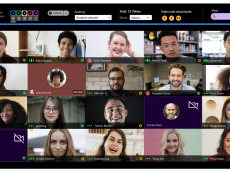
Articles
Education Technology
How to Build an Online Learning Portal
By eLearning Inside
June 28, 2022
Remote learning became necessary as a result of the COVID-19 pandemic, which disrupted the education of 150 countries and 1.6 billion students around the world. By 2025, the global market for online education is expected to hit $350 million. The opportunity and investment in online education have increased rapidly, and school systems are beginning to understand that EdTech is just as part of our present as it is our future.
It’s understandable why more individuals are starting to view the creation of eLearning software as a lucrative business opportunity and a successful way to address the world’s expanding educational demands. Its flexibility in delivery comes down to being available on almost every wifi-connected device, whether that be a computer, smartphone, or iPad. These types of products also give learners a range of learning options and modes, from one-to-one tutoring to self-paced learning, without being in a classroom.
For IT professionals and creators, getting into this market can be intimidating. Fortunately, there are a several ways and practices you can adopt when creating a unique eLearning website.
1. Assess Your Idea
It is no secret that the need for effective and affordable training and educational systems is increasing, but you need to look at the data to properly verify your concept. The statistics indicate that the size of the worldwide e-learning market will exceed $300 billion USD by 2025.
These predictions, according to Sloboda Studio, demonstrate how highly preferred the online learning sector is among investors, creative businesses, and a sizable target audience. Building e-Learning platforms aren’t just e-Learning startups.
Educational institutions and many other offline enterprises are thinking about developing their internet platforms. But how to create an elearning website? What features should be added?
Due to advancements in artificial intelligence, augmented reality, virtual reality, machine learning, big data, and other technologies, you will be able to grow your business in the e-learning sector.
2. Analyze Your Niche in Depth
Finding a problem worth fixing is one of the most important tasks in product development. Your platform won’t function as a crucial market solution if there isn’t an issue. Therefore, before continuing, consider the potential value and advantages your product may provide to its users in the future.
Concentrate on the most popular categories, such as business and entrepreneurship, fitness, health, and personal development, as well as arts and crafts, computer technology, and so on. Consider your learners’ age, gender, and educational history, as well as their main goals and preferred methods of learning.
3. Select a business model
The first thing you must decide before beginning development is the business model. This will define how you use your platform to make money.
There are three options available: paid certificates, where users pay for a platform-verified certificate; subscription-based, where users buy a monthly or yearly subscription that grants them unlimited access to the website; and paid courses, where students pay for courses and the proceeds go to the teacher and the website owner.
4. Implementing essential features
The success of your e-learning website will be determined by its essential features. The proper functionality for your website must be carefully selected and implemented.
You’ll discover that the key features may be broken down into three categories as you work out how to build an online learning platform. The first category includes common characteristics, followed by student profile features and instructor profile features.
5. Engage qualified educators
Without outstanding content, however, even top-notch UI/UX design services and top-notch website functionality would be useless. Outstanding instructors should provide great content.
Therefore, in the future, you’ll need to work with academic institutions like universities or seek qualified teachers. Partner with well-known and knowledgeable tutors and let your students meet them.
Featured image: gorodenkoff, iStock.









No Comments